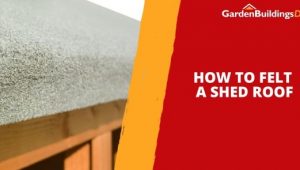Jump to:
Pressure treatment gives timber longer protection. Dip treatment is cheaper but needs re-coating every year to keep the wood safe. Spray treatment is lighter again and only covers for a short time. So, which wooden garden building treatment should you go for?
Read on as we explain how each option works to help you decide.
Pressure Treatment for Wooden Garden Buildings
For wood to count as pressure treated, it must go through a process called pressure treatment. This is also known as vacuum pressure impregnation. There are a lot of pressure-related terms, but we’ll break them down for you.
In pressure treatment, the wood is cut, dried, and placed in a sealed steel cylinder. A vacuum removes the air, and chemical preservatives are then introduced. Hydraulic pressure is applied to force the preservative deep into the timber. A final vacuum extracts any excess solution and aids drying. This process drives protection deep into the wood for long-lasting durability.
When it comes to garden buildings, e.g., pressure treated sheds and pressure treated log cabins, manufacturers handle the work. Companies offer this treatment as a standard, with some providing it as an option. This means they complete the pressure treatment process before delivery.
Keep in mind, though, this adds to the cost, not to mention that dispatch may take longer. The timber can’t go straight from the pressure treatment tank onto a delivery van; it has to dry for a while first to be safe to move. The extra time can range from 2 to 8 weeks, depending on availability, order demand, and location.
A pressure treated garden building may cost more upfront, but it will last longer and spare you annual maintenance. Trusted retailers like Garden Buildings Direct offer a 15-year anti-rot guarantee, so it’s a solid investment that saves money over time.
Dip Treatment in Garden Buildings
Dip treating wood is a less time-consuming process than pressure treating. How it works is also more straightforward. Timber in bulk is dipped into a tank with either a water-based or solvent-based preservative until it’s absorbed into the outer layer of the wood.
Dip treatment is quick and cost-effective, but it’s only possible in an industrial setting. After a year, the timber will be ready for a new coat of treatment, which has to be applied by spray or brush. This annual maintenance is not only recommended but a requirement for warranty guarantees. Dip treatment not as durable and long-lasting as pressure treatment.
Spray Treatment on Timber Structures
Many wooden sheds and other buildings are offered with a factory spray treatment. It looks much like the coloured spray coating you see on outdoor fences or garden furniture. It’s quick and cost-effective, but it only lasts for the duration of its transit after sale.
Ultimately, this type of treatment doesn’t last long. You can reapply it after installation, then keep up with yearly maintenance.
FAQ
Which treatment is best if I want the least maintenance?
Pressure treatment is the best option if you want to avoid regular upkeep. It costs more initially, but it lasts much longer and comes with extended guarantees.
Is dip treatment or spray treatment better for a budget shed?
Dip treatment is better. It at least gives full coverage and can be topped up each year.
How long does dip treatment last?
Dip treatment protects the shed for about 12 months. After that, you need to re-coat it each year to keep the wood safe from rot and damp.
Can I switch from dip to pressure treatment later?
No. Pressure treatment requires special equipment and is only done by manufacturers. If your shed is dip-treated, the best option is to keep re-coating it annually.





